Transforming lives Part 2
The second part of Gavin S Mckay’s extracts from his history of Dundee Dental Hospital and School spans the two world wars and a battle for its very existence in the 1980s
The primary aim of the dental hospital was not just to relieve acute pain and treat infection, because that form of basic treatment was already available at the Dundee Royal Infirmary, but to educate the public to the extent that the children of poor families could become dentally fit and so develop optimally. This required regular dental health checks and some intervention, to conserve tooth tissue by placing fillings as necessary. Although this was expensive, fillings had to be almost free because many patients would not pay for the discomfort of cavity preparation, preferring a one-off extraction. However, treatments to make the patient more aesthetically pleasing were not free so that dentures and orthodontic appliances did have to be paid for.
At this time, Dundee was a city of working women in the textile mills. Some of the spinster girls practised a culture that ran counter to the above aim of a healthy mouth, regular dental inspections and the conservation of teeth. These young women aimed to have all their teeth extracted at a young age and dentures fitted. They believed that this would cure all their future dental problems and improve their chances in the marriage stakes. The same women believed the myth that every pregnancy would cost a couple of teeth because the in utero child would withdraw calcium from her teeth.
The war years
The other primary aim of the dental hospital was to educate and train future dentists. Within two years of opening the hospital, a dental school was set up as a college of St Andrews University and, in 1918, the first LDS (StA) had qualified.
The hospital was set up just before WW1 and although it was initially fully supported by funds from subscription members, by 1920 hospital expenditure was greater than income.
It was during WW2 that funding became a serious problem. As the subscription list got shorter, it became easy to see that about one third of the subscription income was being contributed by the few families of those senior people who were actually running the hospital.
The Second World War had a significant impact on the smooth running of the Dundee Dental Hospital and School, causing significant stress. The most significant single factor was probably the fact that the senior staff were still the same people that had set up the hospital, coped with WW1, had been in post for 25 years and were looking forward to retirement. Graham Campbell was 65 before WW2 started. Neither he nor his brother Gordon were able to retire but rather found themselves with a greater workload because younger staff were required for war service.
Prior to WW2, patient attendances were running at the rate of 20,000 visits per annum in a dental hospital that was too small to cope with the load, and the debit account was still increasing. With the start of war, the board’s annual report bemoaned the fact that the hospital had incurred irrecoverable losses due to expenditure on the construction of air raid protection shelters, blackout fitments and the employment of persons to supervise the prevention of light escape. This was associated with a large drop in patient attendance at the beginning of the war and a decrease in the demand for places to study dentistry, since some potential students were off fighting for king and country. Denture wearers were the one class of paying patient who were not frightened away by the war, so income then rose slightly. As the war drew to a close, the population of Dundee realised that the threat of being bombed was receding and with that the numbers of patients attending the dental hospital clinics increased.
However, more patient treatments meant overcrowded clinics and increasing deficits again.
Up until 1941, the BDS students (fifth year) were used as house surgeons because they were registered dentists (LDS) and so could legally supervise basic clinical work by third and fourth-year students. At this time, postgraduate degrees (including the BDS) were suspended in order to make more intellectuals and professionally qualified persons immediately available to the war effort. The net result of the conscription of all BDS students was to significantly increase the supervisory workload of the reduced numbers of mostly older staff in the hospital. The increased workload then reached almost overload due to external factors. The government imposed additional requirements, including the training of an unknown number of (Austrian Jewish) refugee dentists, on six-month long courses, to prepare for the LDS RCS exams. Senior medical students from the Advanced Medical School in Dundee were added to the teaching load as they were prepared for work in the theatre of war, by undertaking a crash course in the emergency treatments in dentistry.
In a perverse sort of way, the older staff, perhaps because of all the above new inputs and a feeling that they were under scrutiny, made the course requirements for the normal LDS students more demanding. This further stressed both the students and staff.
Once the war was over and the situation was calmly appraised, it was acknowledged that the staff, and Gordon and Graham Campbell in particular, had been overextended by their workload. Two younger men were employed, each to take over a third of Prof Gordon Campbell’s duties. The points total required to be gained from clinical work, for the students to qualify to be able to present for the professional examinations, were reduced. No detailed record exists of how many points were removed from the total work target but it was a sufficiently significant number to be expressed in a couple of other ways. The cost of consumables (probably gold, platinum and ceramics) was reduced sufficiently to show in the accounts, slowing the rate of growth of the deficit. Fewer points meant less advanced conservative dentistry being practised, thus fewer patient hours, so reducing some of the congestion.
The year 1947 was of major importance to Dundee Dental Hospital and School. Arrangements were made for the retirement of Dr Graham Campbell, who would die within a year aged 80, and Professor Gordon Campbell, who died in 1950. When the NHS Scotland Act (1947) was passed, it was evident that many things were about to change. The Act was implemented in 1948, at which time all of the UK dental hospitals and schools were inspected and an inventory taken. The Dundee inspection revealed that no part of the dental hospital could be recognised as being an academic teaching facility.
As a result, the NHS took over the whole of 2 Park Place as a clinical facility and the University had to provide a separate dental school. Without the implementation of the NHS Act, it is more than likely that the Dundee Dental Hospital would have folded due to the twin problems of its financial deficit and an insurmountable space shortage.
This situation was stabilised by a combination of the NHS takeover of the hospital, with the university and University Grants Committee (UGC) to take responsibility for a new dental school.
The appointment of Professor Hitchin as dean of dentistry (clinical lead) and adviser in dental studies (academic) established a strong leader to oversee both. The dental hospital was trebled in size by joining the original villa at 2 Park Place to the adjacent 4 Park Place by means of an intervening uniting piece. A further size increase was achieved by adding a second floor in the form of a mansard roof, spanning all the buildings.
The university view was that the dental school could be created from a combination of existing, underused old buildings – a mend and make-do mentality. Undaunted by opposition, Professor Hitchin proposed a brand new, free-standing dental school, separate from the hospital but capable of being joined to it once intervening properties were demolished. The minutes of University Court referred to the proposals as the ‘Hitchin Plan’. In the fullness of time this is what did happen just as Hitchin had intended. The extended hospital and the first phase of the new school were both opened in 1954 as part of Queen’s College (see Figs 1 and 3). The second phase of the dental school was a 10-storey tower, completed in 1967 and opened in 1968 (see Figs 5 and 6). The tower which joins the hospital and school together is part hospital, part teaching facility and the location of research labs.
The year 1947 was also of major importance to the University College in Dundee. It was felt that the University Court at St Andrews had not properly supported the University Council in Dundee since the end of WW1. As a result, in 1947 Douglas Wimberley, the then principal of University College, instigated a series of inquiries and reports which, in 1952, advocated independence for the university in Dundee. Following the scrutiny of a Royal Commission,
University College was renamed, with the consent of Her Majesty the Queen, as Queen’s College. This new relationship with St Andrews gave the Dundee-based elements of the partnership a greater degree of autonomy and flexibility. The next landmark year was 1967, at which time Queen’s College became the independent University of Dundee.
The man whose actions have left the greatest imprint on Dundee Dental Hospital and School is Prof Hitchin, appointed in 1947 and retired 30 years later in 1977. He was dean of dentistry from 1947 to 1973. During his tenure he oversaw the extension of the dental hospital, and fought for and developed, in two stages, a new dental school which has left us with dental real estate of significant value. One of his arguments used to justify a proper new school was that we had to have facilities and an ambience that our alumni could be proud of. He succeeded and subsequent deans have further developed that sense of belonging. Dundee has been independently assessed as the ‘among the best’ in a range of independent surveys from graduate employability to the views of students.
- Fig 1 – Conservative Dentistry (South Cons) in 1954 – showing large windows in Mansard roof and more light flooding through skylights above. Shown by courtesy of the University of Dundee Archive Services; ACC 2015-708 (11)
- The Integrated Oral Care unit (2015). This clinic has been developed from the area known as South Cons. Compare this with the set-up in Fig 1
- Fig 3 – Prosthetics Department in 1954 – located at the south end of the first floor. Shown by courtesy of the University of Dundee Archive Services; ACC 2015-708 (7)
- Fig 4 – Prosthetics Clinic in 2015 – now located in the dental tower. The dental chairs are organised for effective undergraduate training. There is sufficient privacy for the patient to feel comfortable, yet the clinic is sufficiently ‘open’ for the supervising staff to be aware of all the clinical activity
- Fig 5 – Dental hospital and school complex photographed in 2015, showing the old hospital building (1954) and new tower (1968)
- Fig 6 – The entrance to the modern dental tower. Clinics are located on the first five floors, lecture/study facilities and board room on the sixth floor. Floors seven to 10 inclusive are for teaching, staff offices and research labs
- Fig 7 – Master copy of the Dall Medal. William Dall was the man who made dental ceramics not only a very technical dental speciality but also an aesthetic art form. His grounding in dental ceramics was gained through Walter Campbell (the father) in Dundee
- Fig 8 – “How Long O Lord Holy and True Dost Thou Not Judge and Avenge our Blood” by Douglas Strachan. Gifted by William Boyd, in 1930, in memory of Wm Rettie. Because of its value this piece of stained glass is mounted indoors (side room off the staff canteen) and is artificially back-lit
- Fig 9 – The Summer Sea (1907) – by Sir William McTaggert (1835-1910), This picture is the great treasure of the dental art collection. It is one of McTaggart’s last great period seascapes; painted only three years before his death. Shown by courtesy of the University of Dundee Museum Services; ARTS_172
Threat of closure
As early as 1983 there were central government dental manpower studies which suggested that fewer dentists than were presently planned for would be needed by 2020. This decrease could be dealt with by a small reduction in the intake of students by all dental schools. It was official policy not to produce too many dental graduates. The Department of Health (DoH) also decided that its future manpower requirement would be reviewed periodically after 1984 to allow the number of dental training places to be adjusted by the University Grants Committee (UGC), as required. The DoH review body reported again in July 1987, giving a target of 30,700 dentists for 2025, requiring a 25 per cent increase on the number from the then current planned figure. However, the then minister, Edwina Currie, restated the policy that it was essential not to produce too many dental graduates, and as a consequence a further reduction of 10 per cent in the intake of dental schools was recommended. She informed the House of Commons that “the precise implication for individual schools was a matter for the UGC in conjunction with the Department of Education and Science and other interested parties”.
Concurrently, the UGC had been conducting its review of dentist training provision across the UK. Its inspectors visited all UK dental schools in 1987 knowing that the DoH would recommend a reduction in the number of student places by 10 per cent from 1988. In its report (published in March 1988) an intake of 50 students was set as the minimum number necessary to provide sufficient income for the adequate staffing of a dental school. To achieve this and, at the same time apply the cut, closure of two schools was recommended. The UGC’s Dental Review Working Party (DRWP) had given each school a ranking of A, B or C. (The criterion for these judgements was never disclosed.)
Dental schools are distributed across the UK at major centres of population. Geographic coverage was to be maintained after the cuts. Dundee, along with UCH Dental School London, both graded C, was identified for closure. A Scottish school was chosen because Scotland was considered to be overproducing dentists for Scottish needs and one of the London schools was chosen because there were three others in the city. The report was supported by the BDA who were concerned that too many dentists were being produced for the needs of the UK. The BDA believed that closures were the only way to ensure that the 10 per cent cut would be implemented in full, mindful that the 10 per cent cut ordered by the UGC in 1983, was never fully achieved.
Scotland was considered as a self-contained region within the UK for which there would be a Scottish solution. Clearly, Glasgow (graded A) was safe, whereas either Dundee or Edinburgh (both graded C) would be the candidate for closure. Dundee was to receive the death sentence.
Our analysis of the DRWP report was that the UGC approach was inappropriate in Scotland, arbitrary in its views, divisive in its classifications, naïve in its use of patient attendance figures, and used unquantified evidence and spurious arguments. To us, such a flawed and seemingly amateurish justification for the decision to recommend closure made the production of our fact-based rebuttal an easier task.
The University of London accepted the UGC report and UCH Dental School ceased to admit students from October 1988. Dundee chose to fight on. By July 1988, Dundee’s defence document was ready and a delegation went to meet the UGC on 6 July 1988. Hopes were dashed when the UGC announced, a day later, that it would accept the advice of its subcommittee and close Dundee. However, in the process of making our case, Dundee had convinced the men who were now pivotal – the Scottish Secretary Malcolm Rifkind and the Under-Secretary for Health in Scotland Michael Forsyth.
The 1988 Education Reform Act came into being on 19 July 1988 with the UGC being replaced by the University Funding Council (UFC) to which Sir Donald McCallum was appointed chairman of the Scottish committee. Instead of endorsing the UGC report, Malcolm Rifkind formed a committee under the chairmanship of Sir Donald to review the provision of dental education in Scotland under the UFC.
We got wind of the possible outcome of the McCallum Review from an interview Sir Peter Swinnerton-Dyer (chief executive of the UFC) gave the Glasgow Herald, published on 18 May 1989. In this he said: “Edinburgh (University) had financial problems, in particular, piling up and being ignored. Look at their dental school: it may be sheer bad luck that it is so bad, but to have a dental school that is simultaneously lousy and the most expensive in the British Isles is not a clever thing to do.”
This was indeed a startling media gaffe for Sir Peter to make, but his popularity in Dundee soared and we survived. There is no doubt that the dental real estate in Dundee, built up by Prof Hitchin and presently worth up to £50 million, would have been a factor.
Walter Campbell and William Dall
William Dall was the man who made dental ceramics not only a very technical dental speciality but also an aesthetic art form. Much of the work which led to his registering international patents was carried out in Glasgow, where he had qualified. His grounding in the subject however, both technique and art, was supplied by Walter Campbell in Dundee. Campbell had a national reputation for aesthetic dentures; patients would travel to Dundee from London to be treated by him. His speciality was to use swaged platinum plates on to which long-pin ceramic teeth were soldered and tissue matching facings in porcelain applied. He took edentulous impressions in plaster of Paris for maximum accuracy.
Dall was a workaholic, travelling the world to give lecture demonstrations and wrote textbooks to enable others to use his methods. His excessive work habit is said to have damaged his health. On his death he endowed prizes in Dundee (Fig 7) and Edinburgh Dental Schools and an institute in Glasgow.
Art treasures
No history of the Dundee Dental Hospital and School can be told without reference to its art treasures. Many were the gift of William Boyd, some were presented to Boyd as tokens of appreciation, but the ‘house rules’ were that the artworks were displayed to the staff and patients, to educate and calm the viewer. Boyd was not only a knowledgeable art collector but a supporter of talent.
Stained glass
Our premier sample of stained glass is by Douglas Strachan (Fig 8). He was the outstanding stained glass artist of the early 20th century. In 1913, Strachan won a design competition that resulted in him being selected to make the stained glass windows that became Britain’s gift to the Palace of Peace, Great Court of Justice at The Hague (Holland). He installed four windows, each of four lights at The Hague. The Strachan stained glass window in the dental hospital is one of a total of five designs he submitted for our Scottish National War Memorial in Edinburgh Castle – the other four form the War Memorial.
The purpose of the gift was to recognise the contribution made by William Rettie to the dental hospital. This window is said to depict a scene from the Book of Revelations with the quotation “How Long O Lord Holy & True Dost Thou Not Judge & Avenge our Blood”. The simple title that we use is the “Peace and Tranquillity (of Heaven)” (see Fig 8).
The window has a depiction of Peace and her supporting Angels in the upper half of the window. The lowest part of the window depicts the victims of war and a tomb, its inscription partially obscured. From this region a group of supplicating arms are stretched up towards Peace. Just so that it does not appear too easy to attain tranquillity, the Four Horsemen of the Apocalypse (Famine, Fire, Pestilence and War) ride over the victims and separate them from Heaven. There are Art Nouveau motifs in the border of the window.
Landscape painting
The great treasure of this collection is the magnificent seascape, ‘The Summer Sea’ (see Fig 9), by Sir William McTaggart (1835-1910). This painting is on such a scale that it is best viewed from a distance. The picture was presented to the hospital in 1930 by William Boyd in memory of his brother-in-law.
McTaggart became a trained artist by chance. As an apprentice apothecary, with no art training, he would secretly paint portraits of patients in his master’s waiting room. These pictures were seen and admired, with the result that he was sponsored to move to Edinburgh aged 16, for training and encouragement in his art.
In his early work he was considered avant-garde, using an impressionist style contemporary with the French movement. In fact, he was dubbed the ‘Scottish Impressionist’. His style, with its free handling of paint and a joyous use of colour has undoubtedly influenced modern artists. The bold brushwork and use of colour seen in this landscape hint at the influence of Constable and Turner, whom he admired, as well as the French School. His late phase work, and this is one of his last great period seascapes (1907), have surpassed these earlier works. This particular painting has used both expressionism and impressionism in which, with the use of harmonious colours and refined tone, has combined to give an astonishing brilliance of light to the water.
more info
If you are interested in buying a copy of Transforming lives for 100 years, published by Connect Publications, there are still a few copies available. To buy your copy, priced at just £10, visit bit.ly/DundeeCentenary

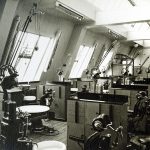
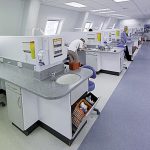
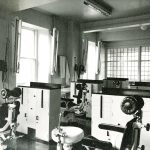
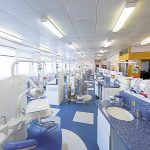
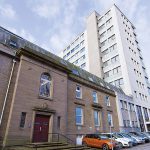

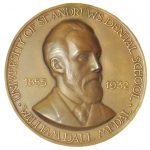
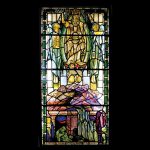

Comments are closed here.